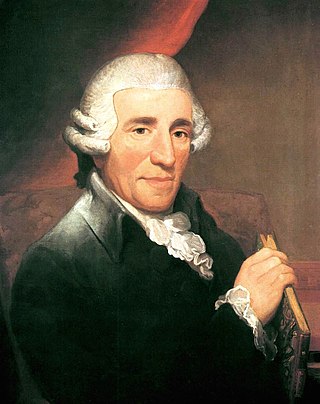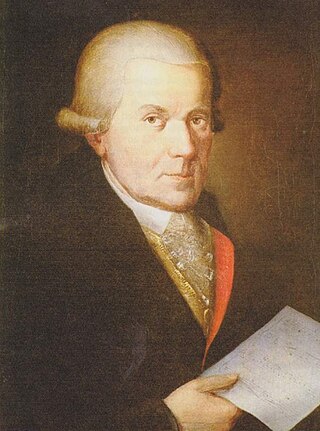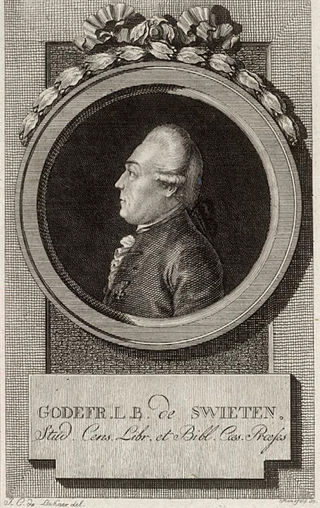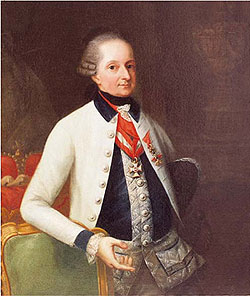Further reading
- The New Grove's current article on Haydn (by Webster and Feder, not by Larsen) includes other material on the term "Papa Haydn".
- Niemetschek, Franz (1798/1956) Life of Mozart, translated by Helen Mautner. London: Leonard Hyman.
The composer Joseph Haydn is sometimes given the nickname "Papa" Haydn. The practice began in Haydn's lifetime and has continued to the present day.
Höslinger (2009) identifies three senses of the term, discussed below in the order of their chronological origin.
"Papa Haydn" started out as a term of affection bestowed on Haydn by the musicians who worked for him. After 1766 Haydn was the Kapellmeister at the Esterházy court, presiding over a fairly large group of musicians. His authority was evidently rather benevolent, as he often interceded with Prince Esterházy on behalf of musicians who had gotten in trouble. [1] The tale of the "Farewell" Symphony attests to Haydn's willingness to act on behalf of his subordinates. The practice of calling Haydn "Papa" became increasingly plausible as Haydn's 30-plus years of service in the Eszterházy court went by; with each year, he would have become increasingly older than the average musician serving under him.
As time went by, the group of musicians who called Haydn "Papa" expanded beyond the Esterházy court [2] and included Haydn's friend Wolfgang Amadeus Mozart. [3]
Höslinger summarizes this aspect of "Papa Haydn" thus: "'Papa' arose as a term of affection, commonly used by the Esterházy players ... for a father figure, somebody who willingly gave advice and who was generally respected as a musician." He notes that in Haydn's time the term was used for other musicians as well; e.g. "Franz Schubert called Salieri his 'Grosspapa' (German: 'grandad')". [4]
Another sense of the term "Papa Haydn" came from his role in the history of classical music, notably in the development of the symphony and string quartet. While Haydn did not invent either genre, his work is considered important enough that the labels "Father of the Symphony" and "Father of the String Quartet" are often attached to him. [5] Even in his own lifetime, this perspective was prevalent. In 1797, the Tonkünstler-Societät of Vienna passed the resolution to make him a life member, "by virtue of his extraordinary merit as the father and reformer of the noble art of music." [6] When in 1798 Franz Niemetschek published a biography of Mozart, he dedicated the book to Haydn, calling him "father of the noble art of music and favorite of the Muses."
Höslinger asserts that this usage of "Papa Haydn" increased during the 19th century, "as the sense of reverence for older composers increased." [4]
This usage, which arose in the 19th century, is characterized thus by Höslinger: it is "a more patronizing, even dismissive one. In comparison with Romantic artists and Romantic music, Haydn and his output were seen as genial, but naive and superficial."
With the rise of acclaim for Haydn's music during the 20th century, the patronizing sense of "Papa Haydn" caused scholars and critics to become leery of the term, seeing it as a distortion of the composer's work. For example, Haydn scholar Jens Peter Larsen wrote (1980):
For years the nickname 'Papa Haydn' has characterized the composer. Used by his own musicians and others as a tribute of affection and respect, the expression increasingly took on misleading connotations, and came to signify a benevolent but bewigged and old-fashioned classic. The recent revival of interest in Haydn's music has made plain that the traditional picture had become a caricature, and that it gave a false impression of richness and diversity of his development as a composer. [7]
"Papa Haydn" was used in a children's song, sung to the first bars of the second movement of the Surprise Symphony :
Papa Haydn's dead and gone
but his memory lingers on.
When his mood was one of bliss
he wrote jolly tunes like this. [8]

The Classical Period was an era of classical music between roughly 1750 and 1820.

Franz Joseph Haydn was an Austrian composer of the Classical period. He was instrumental in the development of chamber music such as the string quartet and piano trio. His contributions to musical form have led him to be called "Father of the Symphony" and "Father of the String quartet".

Wolfgang Amadeus Mozart was a prolific and influential composer of the Classical period. Despite his short life, his rapid pace of composition resulted in more than 800 works representing virtually every Western classical genre of his time. Many of these compositions are acknowledged as pinnacles of the symphonic, concertante, chamber, operatic, and choral repertoire. Mozart is widely regarded as one of the greatest composers in the history of Western music, with his music admired for its "melodic beauty, its formal elegance and its richness of harmony and texture".
Kapellmeister, from German Kapelle (chapel) and Meister (master), literally "master of the chapel choir", designates the leader of an ensemble of musicians. Originally used to refer to somebody in charge of music in a chapel, the term has evolved considerably in its meaning and is today used for denoting the leader of a musical ensemble, often smaller ones used for TV, radio, and theatres.

The term string quartet refers to either a type of musical composition or a group of four people who play them. Many composers from the mid-18th century onwards wrote string quartets. The associated musical ensemble consists of two violinists, a violist, and a cellist. The double bass is almost never used in the ensemble mainly because it would sound too loud and heavy.

Johann Michael Haydn was an Austrian composer of the Classical period, the younger brother of Joseph Haydn.

Gottfried Freiherr van Swieten was a Dutch-born Austrian diplomat, librarian, and government official who served the Holy Roman Empire during the 18th century. He was an enthusiastic amateur musician and is best remembered today as the patron of several great composers of the Classical era, including Carl Phillip Emanuel Bach, Joseph Haydn, Wolfgang Amadeus Mozart, and Ludwig van Beethoven.
Sonata form is one of the most influential ideas in the history of Western classical music. Since the establishment of the practice by composers like C.P.E. Bach, Haydn, Mozart, Beethoven, and Schubert and the codification of this practice into teaching and theory, the practice of writing works in sonata form has changed considerably.

Nikolaus I, Prince Esterházy was a Hungarian prince, a member of the famous Esterházy family. His building of palaces, extravagant clothing, and taste for opera and other grand musical productions led to his being given the title "the Magnificent". He is remembered as the principal employer of the composer Joseph Haydn.

The composers Wolfgang Amadeus Mozart (1756–1791) and Joseph Haydn (1732–1809) were friends. Their relationship is not very well documented, but the evidence that they enjoyed each other's company is strong. Six string quartets by Mozart are dedicated to Haydn.
Gregor Joseph Werner was an Austrian composer of the Baroque period, best known as the predecessor of Joseph Haydn as the Kapellmeister of the Hungarian Esterházy family. Few of Werner's works survive to the present day, and he is mostly remembered for his troubled relationship with Haydn.
Mathias Haydn was the father of two famous composers, Joseph and Michael Haydn. He worked as a wheelwright in the Austrian village of Rohrau, where he also served as Marktrichter, an office akin to village mayor.

Count Karl Joseph of Morzin (1717–1783) was a Bohemian aristocrat from the Morzin family, remembered today as the first person to employ the composer Joseph Haydn as his Kapellmeister, or music director. The first few of Haydn's many symphonies were written for the Count.

The six string quartets Op. 20 by Joseph Haydn are among the works that earned Haydn the sobriquet "the father of the string quartet". The quartets are considered a milestone in the history of composition; in them, Haydn develops compositional techniques that were to define the medium for the next 200 years.
The Gesellschaft der Associierten was an association of music-loving noblemen centered in Vienna and founded by Baron Gottfried van Swieten in 1786. The society sponsored concerts, often reviving music from the past, and also commissioned new works.
This article discusses the influence of folk music on the work of the composer Joseph Haydn (1732–1809).

Christoph Sonnleithner was an Austrian jurist and composer. He was the father of Ignaz von Sonnleithner and Joseph Sonnleithner. His daughter Anna was the mother of Franz Grillparzer.

Joseph Haydn wrote 123 trios for the unusual combination of baryton, viola and cello. Three further trios for baryton, cello and violin are considered part of the series. As Sisman notes, they are the “most intensively cultivated genre” of Haydn’s early career.